| PA-31 | |
|---|---|

| |
| Piper PA-31 Navajo, with aftermarket winglets installed | |
| Role | Utility aircraft |
| Manufacturer | Piper Aircraft |
| First flight | 30 September 1964[1] |
| Introduction | 30 March 1967 |
| Status | Active service |
| Produced | 1967–1984[2] |
| Number built | 3942[3] |
| Variants | Piper PA-31T Cheyenne |
The Piper PA-31 Navajo is a family of twin-engined utility aircraft designed and built by Piper Aircraft for small cargo and feeder airlines, and as a corporate aircraft. Production ran from 1967 to 1984. It was license-built in a number of Latin American countries.
Development
[edit]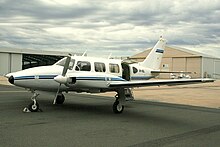
In 1962, Piper began developing a six- to eight-seat twin-engined corporate and commuter transport aircraft under the project name Inca, at the request of company founder William T. Piper.[2][4] Looking like a scaled-up PA-30 Twin Comanche, the PA-31 made its first flight on 30 September 1964, and was announced later that year.[1][4] It is a low-wing monoplane with a conventional tail, powered by two 310 hp (231 kW) Lycoming TIO-540-A turbocharged engines in "tiger shark" cowlings, a feature shared with the Twin Comanche and the PA-23 Aztec.[4][5][6]
As testing proceeded, two cabin windows were added to each fuselage side and the engines were moved further forward.[6][7] The PA-31, named "Navajo" after the native American tribe, was certified by the FAA on 24 February 1966, again in mid-1966 with an increase in maximum takeoff weight (MTOW) from 6,200 to 6,500 lb (2,812 to 2,948 kg), and deliveries began in 1967.[2][8]
The PA-31-300 was certified by the FAA in June 1967, the only variant without turbocharged engines: 300 hp (224 kW) Lycoming IO-540-M1A5 engines driving two-bladed propellers.[8] Unofficially, the initial model was referred to as the PA-31-310. Only 14 PA-31-300 were built in 1968 and 1969: the smallest variant production.[2][9]

In January 1966, development of the PA-31P Pressurized Navajo had begun : Piper's first pressurized aircraft.[10] The PA-31P (or PA-31P-425 unofficially) was certified in late 1969.[11] It was powered by 425 hp (317 kW) Lycoming TIGO-541-E engines, had a longer nose, fewer and smaller windows, 25 US gal (95 L) fuel tanks in the engine nacelles and a one-piece airstair cabin entry door instead of the split pair of doors.[2][11][10] MTOW was increased to 7,800 lb (3,538 kg).[11] The PA-31P was produced from 1970 to 1977.[2]
The 1971 Navajo B featured air conditioning, new storage lockers in the rear of the engine nacelles, increased baggage space, a third door next to the cabin doors for easier baggage loading, and an optional separate door for the pilot to enter the cockpit.[3][12]

In September 1972, Piper unveiled the PA-31-350 Navajo Chieftain, a Navajo B stretched by 2 ft (61 cm) for up to ten seats, with more powerful engines and counter-rotating propellers to prevent critical engine handling problems.[8][13] The Chieftain was powered by 350 hp (261 kW) Lycoming TIO-540 variants, with an opposite-rotation LTIO-540 on the right-hand wing, and MTOW was increased to 7,000 lb (3,175 kg).[8] Deliveries started in 1973, after a delay due to a flood caused by Hurricane Agnes at Piper's factory in Lock Haven, Pennsylvania.[13][14]
The 1974 PA-31-325 Navajo C/R was base on the Navajo B.[15] The Navajo C/R had 325 hp (242 kW), lower rated versions of the Chieftain's counter-rotating engines.[8] It was certified in May 1974, and production commenced in the 1975 model year.[15] The Navajo B was also superseded in 1975 by the Navajo C.[15]
In May 1981, Piper established its T1000 Airliner Division at its Lakeland, Florida, factory.[16] The PA-31-350T1020 (or T1020) was a PA-31-350 Chieftain optimized for and marketed for the commuter airline market, without the 40 US gal (151 L) auxiliary fuel tanks in each wing.[8] Up to eleven seats could be fitted, and baggage capacity was reduced from 700 to 600 lb (318 to 272 kg) maximum.[8] The first T1020 was delivered in December 1981.[17]
The PA-31T3 (T1040) was a hybrid with the PA-31-350T1020 main fuselage, and the nose and tail of the PA-31T1 Cheyenne I.[18] The wings were similar to the Cheyenne I's, but with reduced fuel capacity and baggage lockers in the engine nacelles similar to those of the Chieftain.[11] An optional underbelly cargo pod was also available.[11][18] The Pratt & Whitney Canada PT6A-11 turboprop engines were the same as those of the Cheyenne I.[11] Deliveries began in July 1982.[17] A T1050 variant was proposed, with a fuselage stretch of 11 ft 6 in (3.51 m) and seating capacity for 17, but did not proceed.[18]
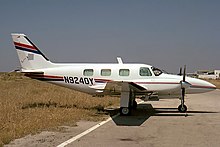
The PA-31P-350 Mojave was also a hybrid, a piston-engined Cheyenne.[19] The Mojave combined the Cheyenne I fuselage with the Chieftain tail.[19] The Chieftain's wings were strengthened, their span was 4 ft (1.2 m) wider and the fuel capacity was enlarged to 243 US gal (920 L).[19] The engines variants had intercoolers, and the rear part of the nacelles were baggage lockers.[19] The Mojave's MTOW rose by 200 lb (91 kg) to 7,200 lb (3,266 kg).[8][11] Certified in 1983, like the T1020 and T1040, the Mojave was produced in 1983 and 1984; combined production with the T1020 and T1040 was below 100 aircraft.[11][14][18] Two experimental PA-31-353s were also built in the mid-1980s.[14]
Licensed manufacture
[edit]The PA-31 series was manufactured under licence in several countries from kits of parts supplied by Piper.[20][21] Chincul SACAIFI in Argentina assembled most of the series as the PA-A-31, PA-A-31-325, PA-A-31P and PA-A-31-350 and Aero Industrial Colombiana SA (AICSA) in Colombia assembled PA-31, PA-31-325 and PA-31-350 aircraft.[22] The PA-31-350 Chieftain was also assembled under licence in Brazil by Embraer as the EMB 820C Navajo.[23][21] In 1984, Embraer subsidiary company Indústria Aeronáutica Neiva began converting Embraer EMB 820Cs by installing Pratt & Whitney Canada PT6 turboprop engines; Neiva called the converted aircraft the Carajá.[24]
Variants
[edit]
- PA-31 Navajo
- Initial production version, also known unofficially as the PA-31-310.[2][8]
- PA-31-300 Navajo
- Variant of the Navajo with normally aspirated engines; 14 built.[2][9]
- PA-31 Navajo B
- Marketing name for 1971 improved variant with 310 hp (231 kW) Lycoming TIO-540-E turbo-charged piston engines, new airconditioning and optional pilot access door and optional wide utility door.[3]
- PA-31 Navajo C
- Marketing name for 1974 improved variant with 310 hp (231 kW) Lycoming TIO-540-A2C engines and other minor improvements.[3]
- PA-31P Pressurized Navajo
- Pressurized version of the PA-31 Navajo, powered by two 425-hp (317-kW) Lycoming TIGO-541-E1A piston engines.[2][11]
- PA-31-325 Navajo
- Referred to as the "Navajo C/R" for Counter-rotating; variant of Navajo with counter-rotating engines introduced with the PA-31-350 Chieftain. 325 hp (242 kW) Lycoming TIO-540 / LTIO-540 engines
- PA-31-350 Chieftain
- Stretched version of the Navajo with more powerful 350-hp (261-kW) counter-rotating engines (a Lycoming TIO-540 and a Lycoming LTIO-540) to eliminate critical engine issues.
- PA-31P-350 Mojave
- Piston-engined variant of the PA-31T1 Cheyenne I; 50 aircraft built.[11]
- PA-31-350T1020
- Also known as the T1020/T-1020; variant of the PA-31-350 Chieftain optimised for commuter airline use, with less baggage and fuel capacity and increased seating capacity (nine passengers). First flight September 25, 1981. 21 built.[8][25][26]
- PA-31T3
- Also known as the T1040/T-1040; turboprop-powered airliner with fuselage of the PA-31-350T1020, and wings, tail and Pratt & Whitney Canada PT6A-11 engines of PA-31T Cheyenne. First flight July 17, 1981. 24 built.[14][27]
- PA-31-353
- Experimental version of PA-31-350; two built.[14]
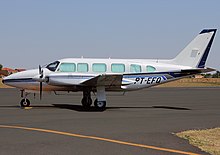
- T1050
- Unbuilt airliner variant with fuselage lengthened by 11 ft 6 in (3.51 m) compared to the PA-31-350.
- EMB 820C
- Version of Chieftain built under license by Embraer in Brazil.
- Neiva Carajá
- Turboprop conversion of EMB 820C, fitted with two Pratt & Whitney Canada PT6A-27 engines flat-rated to 550shp. The Carajá's MTOW of 8,003 pounds (3,630 kg) was 1,000 pounds (454 kg) more than that of the Chieftain.[24]
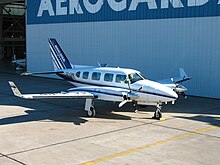
- Colemill Panther
- Re-engined Navajo with 350 hp (261 kW) Lycoming TIO-540-J2B engines, four-blade Hartzell "Q-Tip" propellers and optional winglets. Conversion designed by Colemill Enterprises of Nashville, Tennessee.[28][29] The supplemental type certificates (STCs) were subsequently sold to Mike Jones Aircraft Sales, which continues to convert PA-31, PA-31-325 and PA-31-350 variants with Colemill-developed features.[30][31]
| Type | Built | Location |
|---|---|---|
| PA-31 | 1785 | Lock Haven Lakeland |
| PA-31-350 | 1825 | Lock Haven Lakeland |
| T-1020 | 21 | Lakeland |
| PA-31-353 | 2 | Lakeland |
| PA-31P | 259 | Lock Haven |
| PA-31P-350 | 50 | Lock Haven |
| Total | 3942 |
Operators
[edit]Civil
[edit]The Navajo family is popular with air charter companies, small feeder airlines and commuter air carriers in many countries,[citation needed] and is also operated by private individuals and companies.
The PA-31 Navajo was also formerly operated in scheduled passenger airline service in the U.S. in 1968 by Air West, the predecessor of Hughes Airwest which in turn subsequently became an all-jet airline.[32][33] West Coast Airlines, the predecessor of Air West, began operating the PA-31 Navajo in passenger service in 1967 and called the aircraft the "MiniLiner".[34] West Coast, which was also operating Douglas DC-9-10 jets and Fairchild F-27 turboprops at the time, claimed to be the first "regular airline" to operate the PA-31 Navajo in scheduled service.[35][36]
Military
[edit]- Chile
- Chilean Navy purchased a single PA-31 in 1971.[37]
- Colombia
- Dominican Republic
- Dominican Republic Air Force operates two PA-31s as of December 2018.[39]
- Finland
- Finnish Air Force operated the PA-31-350 Chieftain in the liaison and light transport role.[40]
- France
- French Navy former operator[41]
- Honduras
- Honduran Air Force operates one PA-31 as of December 2018.[39]
- Kenya
- Kenya Air Force operated a Navajo Chieftain in the VIP role.[42]
- Spain
- United Kingdom
Accidents and incidents
[edit]- December 3, 1983: SouthCentral Air Flight 59, a PA-31-350 registered N35206, carrying eight passengers and one pilot, was on the takeoff roll at Anchorage International Airport when it collided head-on with Korean Air Lines Flight 084, a McDonnell Douglas DC-10-30 freighter HL7339. The Piper struck the DC-10's left and center main landing gear and three passengers sustained minor injuries; the DC-10 overran the runway and the three crew suffered serious injuries. Investigators determined that the Korean Air Lines pilot had become disoriented taxiing in fog, failed to follow correct procedures and confirm his position, and accidentally initiated takeoff from the wrong runway. Both aircraft were severely damaged and were written off.[45]
- May 31, 2000: Whyalla Airlines Flight 904 was a scheduled commuter flight, operated by a Piper PA-31 Navajo which crashed while attempting to ditch in the Spencer Gulf, South Australia after suffering failures of both engines on the evening of 31 May 2000. All 8 people on board the aircraft were killed as a result of the accident. The findings of a subsequent investigation by the Australian Transport Safety Bureau highlighting the airline's operating procedures as a key factor leading to the accident were later overturned after they were contradicted by evidence presented at a coronial inquiry into the deaths of those on board the flight.[46] The safety implications arising from the accident were subject to a recall by engine manufacturer Textron Lycoming which saw close to 1000 aircraft grounded worldwide while defects were rectified at an estimated cost of $A66 million. Australia's aviation regulator, the Civil Aviation Safety Authority also mandated lifejackets be carried on all aircraft operating over water after the crash.[47]
Aircraft on display
[edit]- Spain
- A PA-31P Pressurized Navajo formerly operated by the Spanish Air Force is on display at the Museo del Aire in Madrid.[43]
Specifications (PA-31 Navajo)
[edit]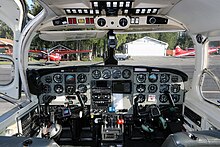

Data from Jane's All The World's Aircraft 1976–77 [48]
General characteristics
- Crew: 1 or 2
- Capacity: 5 to 7 passengers
- Length: 32 ft 7+1⁄2 in (9.94 m)
- Wingspan: 40 ft 8 in (12.40 m)
- Height: 13 ft 0 in (3.96 m)
- Wing area: 229 sq ft (21.3 m2)
- Airfoil: NACA 634415 at root, 631212
- Empty weight: 3,930 lb (1,783 kg)
- Max takeoff weight: 6,500 lb (2,948 kg)
- Fuel capacity: 190 US gal (160 imp gal; 720 L) total, 187 US gal (156 imp gal; 710 L) useable
- Powerplant: 2 × Lycoming TIO-540-A air-cooled six-cylinder horizontally opposed piston engine, 310 hp (230 kW) each
- Propellers: 3-bladed Hartzell metal, fully feathering propellers, 6 ft 8 in (2.03 m) diameter
Performance
- Maximum speed: 261 mph (420 km/h, 227 kn) at 15,000 ft (4,600 m)
- Cruise speed: 238 mph (383 km/h, 207 kn) at 20,000 ft (6,100 m) (econ. cruise)
- Stall speed: 73 mph (117 km/h, 63 kn) (flaps down)
- Never exceed speed: 272 mph (438 km/h, 236 kn) [8]
- Range: 1,165 mi (1,875 km, 1,012 nmi) at 20,000 ft (6,100 m) (econ. cruise speed)
- Service ceiling: 26,300 ft (8,000 m)
- Rate of climb: 1,445 ft/min (7.34 m/s)
See also
[edit]Related development
Aircraft of comparable role, configuration, and era
References
[edit]Citations
[edit]- ^ a b Taylor 1976, p.354.
- ^ a b c d e f g h i "The Piper PA-31 Navajo/Pressurized Navajo". airliners.net. 2009. Archived from the original on April 28, 2010. Retrieved January 13, 2009.
- ^ a b c d e Peperell 1987, pp. 179-201
- ^ a b c "World News: Piper's New Medium Twin". Flight International, Volume 86, Number 2911, 24 December 1964, p.1065. Retrieved 2010-04-05
- ^ Lambert (1963), p.470
- ^ a b "Refinements in the Piper range". Flight International, Volume 87, Number 2922, 11 March 1965, p.367. Retrieved 2010-04-05
- ^ "Air Report", Flight Magazine (1965), p.7
- ^ a b c d e f g h i j k FAA Type Certificate A20SO for Piper PA-31 / PA-31-300 / PA-31-325 / PA-31-350 series aircraft retrieved 2010-04-01
- ^ a b Piper Aircraft Inc. Customer Service Information, p.38
- ^ a b "Light Commercial & Business: High-flying Navajo". Flight International, Volume 97, Number 3191, p.775. Retrieved 2010-04-08
- ^ a b c d e f g h i j FAA Type Certificate A8EA for Piper PA-31P / PA-31T1 / PA-31T2 / PA-31T3 / PA-31P-350 series aircraft retrieved 2010-04-03
- ^ "NBAA and after" Flight International magazine, 14 October 1971, p.603 (online archive version) retrieved 2010-04-05
- ^ a b "Piper announces Navajo Chieftain" Flight International magazine, 14 September 1972, p.360 (online archive version) retrieved 2010-04-06
- ^ a b c d e "Piper PA-31 Chieftain/Mojave/T-1020/T-1040". airliners.net. Archived from the original on April 28, 2010. Retrieved April 6, 2010.
- ^ Levy (1983), p.1152
- ^ a b Levy (1983), p.1153
- ^ a b c d Barnett (1983), p.833
- ^ a b c d Barnett, Cliff. "Pressurised comfort, piston costs: Mojave flight test", Flight International magazine, 5 November 1983, p.1232 (online archive version) retrieved 2010-04-05
- ^ "Argentine Piper factory" Flight International magazine, 10 May 1973, p.700 (online archive version) retrieved 2010-04-11
- ^ a b Agência Nacional de Aviação Civil Type Certificate EA-7505-02 for EMB 820C Navajo aircraft Archived 2010-12-14 at the Wayback Machine retrieved 2010-04-11
- ^ Marsh (2006), p.49
- ^ Bonelli and Pinheiro, (2008), p.34.
- ^ a b "Caraja deliveries start", Flight International magazine, 12 January 1985, p.12 (online archive version) retrieved 2010-04-03
- ^ Manual P/No. 761-775, Introduction, p.3
- ^ Taylor 1982, pp. 450–451.
- ^ Taylor 1982, p. 451.
- ^ Colemill Enterprises. "Colemill Pather conversion". Archived from the original on August 15, 2010. Retrieved May 21, 2011.
- ^ Michell 1994, p. 305.
- ^ "FAA Supplemental Type Certificate SA970SO" (PDF). faa.gov. Retrieved April 20, 2017.
- ^ "A total renovation of the PA-31".
- ^ http://www.timetableimages.com, July 1, 1968 Air West system timetable, page 9
- ^ https://www.timetableimages.com/i-or/rw7203a.jpg
- ^ "WCgigantic67".
- ^ "West Coast Airlines".
- ^ "WCgigantic67".
- ^ Hatch, Paul (August 1985). "Air Forces of the World: Chilean Naval Air Service". Air Pictorial. Vol. 47, no. 8. p. 291.
- ^ a b "World Air Forces 2022". Flightglobal. 2022. Retrieved July 18, 2022.
- ^ a b Hoyle Flight International 4–10 December 2018, p. 43.
- ^ Sixma and Laukkanen Air International July 1986, p. 12.
- ^ "Piper PA31 Navajo". Netmarine.net. Retrieved April 3, 2014.
- ^ Wheeler Flight International 4 August 1979, p. 364.
- ^ a b “Piper Navajo”, information placard, Museo del Aire
- ^ "Aircraft ZF622 (1980 Piper PA-31-350 Navajo Chieftain C/N 31-8052033) Photo by Malcolm Clarke (Photo ID: AC437577)". airport-data.com. Retrieved April 20, 2017.
- ^ "Korean Air Lines McDonnell Douglas DC-10-30, HL7339, SouthCentral Air Piper PA-31-350, N35206, Anchorage, Alaska, December 23, 1983" (PDF). National Transportation Safety Board. August 9, 1984. Archived from the original (PDF) on August 25, 2021. Retrieved August 29, 2021.
- ^ Chivell, Wayne (July 24, 2003). "Findings of Inquest". airsafety.com.au.
- ^ Milovanovic, Selma (January 29, 2003). "Air crash inquest enters final chapter". The Age.
- ^ Taylor 1976, p.354–355.
Bibliography
[edit]- Barnett, Cliff. "Piper looks ahead". Flight International, 24 September 1983, Vol. 124, No. 3881. p.833.
- Bonelli, Regis and Pinheiro, Armando Castelar. New Export Activities in Brazil: Comparative Advantage, Policy or Self-Discovery, Research Network Working Paper #R-551, Inter-American Development Bank, July 2008.
- Flight Magazine, Volume 54, No. 11, November 1965. Air Review Publishing Corporation, Dallas, Texas.
- Hoyle, Craig. "World Air Forces Directory". Flight International, 4–10 December 2018, Vol. 194, No. 5665, pp. 32–60. ISSN 0015-3710
- Lambert, Mark. "In the air: Piper PA-30 Twin Comanche." Flight International, 12 September 1963, Vol. 84, No. 2844, pp. 468–470.
- Levy, Howard. "Piper consolidates at Lakeland". Flight International, 30 April 1983, Vol. 123, No. 3860, pp. 1152–1153.
- Marsh, David. EUROCONTROL Trends in Air Traffic Volume 1: Getting to the Point: Business Aviation in Europe. European Organisation for the Safety of Air Navigation (EUROCONTROL) May 2006. Retrieved 2010-04-11.
- Michell, Simon. Jane's Civil and Military Aircraft Upgrades 1994–95. Coulsdon, UK: Jane's Information Group, 1994. ISBN 0-7106-1208-7.
- Piper Aircraft Inc. Customer Service Information File 2009 retrieved 2010-04-08
- Piper Airplane Parts Catalog: PA-31 Navajo, PA-31-300 Navajo, PA-31-325 Navajo C/R; September 10, 2009. Piper Aircraft Corporation, Manual Part Number 753-703
- Piper Navajo Information Manual, Revision 9, March 18, 1994. Piper Aircraft Corporation, Manual Part Number 761-723
- Piper Navajo Pilot's Operating Manual, Revision 34, April 22nd 2002. Piper Aircraft Corporation, Manual Part Number 761-456
- Piper T1020 Parts Catalog, Revision 10, September 10, 2009. Piper Aircraft Corporation, Manual Part Number 761-775
- Sixma, Herman J. and Jyrki Laukkanen. "Far Northern Air Force: The Finnish Air Arm Today". Air International, July 1986, Vol. 31, No. 1. pp. 7–13. ISSN 0306-5634.
- Taylor, John W. R. Jane's All The World's Aircraft 1976–77. London: Jane's Yearbooks, 1976, ISBN 0-354-00538-3.
- Taylor, John W. R. Jane's All The World's Aircraft 1982–83. London: Jane's Yearbooks, 1982, ISBN 0-7106-0748-2.
- Wheeler, Barry C. "World's Air Forces 1979". Flight International, 4 August 1979, Vol. 116, No. 3672. pp. 333–386.
Piper aircraft | |||||||||||||
|---|---|---|---|---|---|---|---|---|---|---|---|---|---|
| Company Numerical designations |
| ||||||||||||
| Names |
| ||||||||||||
| Military designations |
| ||||||||||||
Swedish military aircraft designations 1926–current | |
|---|---|
| Attack aircraft (A) | |
| Bombers (B) | |
| Army aeroplanes (Fpl) | |
| Gliders (G/Lg/Se) | |
| Helicopter (Hkp) | |
| Fighters (J) | |
| Advanced trainers (Ö) | |
| Trials aircraft (P) | |
| Reconnaissance (S) | |
| Trainers (Sk) | |
| Torpedo bombers (T) | |
| Transports (Trp/Tp) | |
Spanish Armed Forces trainer aircraft designations | |
|---|---|
| Escuela Elemental (EE) Primary Trainer | |
| Escuela Superior (ES) Advanced Trainer | |
| Entrenamiento (E) Trainer | |
| |